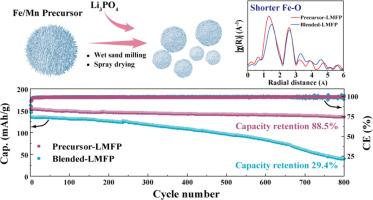Hierarchical LiMn0.6Fe0.4PO4 microspheres with atomic mixture of Fe/Mn derived from (Mn0.6Fe0.4)3(PO4)2·xH2O precursors for high stability lithium ion batteries
IF 20.2
1区 材料科学
Q1 CHEMISTRY, PHYSICAL
引用次数: 0
Abstract
LiMnxFe1-xPO4/C (LMFP) is one of the most promising alternatives of LiFePO4 (LFP) for next generation high energy lithium-ion batteries (LIBs) due to its higher working potential. However, when the substitution level of Fe with Mn exceeds half, the resulting inhomogeneous distribution of Fe/Mn may subsequently impede the performance of lithium manganese iron phosphate (LMFP) in terms of its rate capability, long-term cyclability. In this study, a multi-strategy synergistic modification approach was employed to address the aforementioned issues. First of all, the atomic-level mixing of iron and manganese was achieved by synthesizing the microsphere (Mn0.6Fe0.4)3(PO4)3·xH2O precursor while nanoscale primary particles coated with uniform carbon layer were agglomerated into hierarchical LiMn0.6Fe0.4PO4 microspheres through spray-drying to enhance the tap density and electrical conductivity. XAFS measurements reveal a shorter Fe-O bond length, which is beneficial for maintaining the structural stability of the LMFP. Moreover, in situ XRD analysis confirms the occurrence of complete solid-solution behavior during cycling, which minimizes the transport energy barrier at the interface of the two phases and enhances the kinetic properties. Furthermore, in situ XAFS verifies the redox reactions of transition metals in LiMn0.6Fe0.4PO4 occur with a high degree of reversibility during electrochemical cycling. Consequently, as prepared microspherical LiMn0.6Fe0.4PO4 cathode material demonstrates high tap density (1.28 g ml−1), excellent rate performance with a capacity of 137 mAh g−1 at a high rate of 3C and long cycling stability with capacity retention of 88.5 % after 800 cycles as well as minimal voltage decay of 0.21 mV per cycle.

由(Mn0.6Fe0.4)3(PO4)2·xH2O前驱体衍生出Fe/Mn原子混合物的分层LiMn0.6Fe0.4PO4微球,用于高稳定性锂离子电池
LiMnxFe1-xPO4/C (LMFP)由于具有更高的工作潜力,是下一代高能锂离子电池(LIBs)中最有前途的LiFePO4 (LFP)替代品之一。然而,当Fe与Mn的取代水平超过一半时,由此产生的Fe/Mn的不均匀分布可能随后阻碍磷酸锰铁锂(LMFP)在其速率能力和长期循环性方面的性能。本研究采用多策略协同修正方法来解决上述问题。首先,通过合成微球(Mn0.6Fe0.4)3(PO4)3·xH2O前驱体实现铁锰的原子级混合,并通过喷雾干燥将包覆均匀碳层的纳米级初级颗粒凝聚成层次状的LiMn0.6Fe0.4PO4微球,以提高轻接密度和电导率。XAFS测试表明,Fe-O键长度较短,有利于维持LMFP的结构稳定性。此外,原位XRD分析证实了循环过程中存在完全固溶行为,使两相界面的输运能垒最小化,提高了动力学性能。此外,原位XAFS验证了电化学循环过程中过渡金属在LiMn0.6Fe0.4PO4中的氧化还原反应具有高度可逆性。结果表明,制备的微球形LiMn0.6Fe0.4PO4阴极材料具有高的分接密度(1.28 g ml−1)、优异的速率性能(在高3C速率下容量为137 mAh g−1)、长循环稳定性(800次循环后容量保持率为88.5%)和最小的电压衰减(每循环0.21 mV)。
本文章由计算机程序翻译,如有差异,请以英文原文为准。
求助全文
约1分钟内获得全文
求助全文
来源期刊

Energy Storage Materials
Materials Science-General Materials Science
CiteScore
33.00
自引率
5.90%
发文量
652
审稿时长
27 days
期刊介绍:
Energy Storage Materials is a global interdisciplinary journal dedicated to sharing scientific and technological advancements in materials and devices for advanced energy storage and related energy conversion, such as in metal-O2 batteries. The journal features comprehensive research articles, including full papers and short communications, as well as authoritative feature articles and reviews by leading experts in the field.
Energy Storage Materials covers a wide range of topics, including the synthesis, fabrication, structure, properties, performance, and technological applications of energy storage materials. Additionally, the journal explores strategies, policies, and developments in the field of energy storage materials and devices for sustainable energy.
Published papers are selected based on their scientific and technological significance, their ability to provide valuable new knowledge, and their relevance to the international research community.
 求助内容:
求助内容: 应助结果提醒方式:
应助结果提醒方式:


